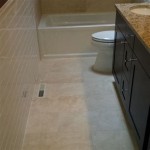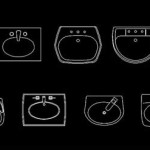Bathroom Sink Clogged: A Comprehensive Guide to Using Drano
A clogged bathroom sink is a common household issue, disrupting daily routines and potentially leading to more significant plumbing problems if left unaddressed. While various methods exist to clear such blockages, Drano, a chemical drain cleaner, is a frequently chosen solution due to its perceived convenience and readily available nature. This article provides a detailed examination of using Drano to unclog a bathroom sink, outlining its mechanism of action, potential benefits, limitations, safety precautions, and alternative methods to consider.
Drano's effectiveness stems from its chemical composition, which typically includes ingredients like sodium hydroxide (lye) and sodium hypochlorite (bleach), often combined with other chemicals such as aluminum. When these chemicals react with water and organic matter within the drain, a series of exothermic reactions occur, generating heat. This heat helps to break down grease, hair, soap scum, and other common clog-causing substances. The reaction also produces gases, which can help to dislodge the blockage physically.
Although Drano can be effective in dissolving some types of clogs, it is essential to understand its limitations. The type and severity of the clog significantly impact its efficacy. For instance, a clog comprised mainly of hair and grease may respond well to Drano treatment. However, solid objects like toys, large clumps of hair, or mineral buildup may not be significantly affected and could even be worsened by the chemical reaction, potentially solidifying around the object and creating a more intractable blockage.
Understanding How Drano Works in Your Drain
The chemical processes within Drano are primarily aimed at dissolving organic matter that constitutes most bathroom sink clogs. Sodium hydroxide, a strong base, saponifies fats and oils, effectively turning them into soap-like substances that are more easily washed away. Sodium hypochlorite acts as an oxidizing agent, further breaking down organic compounds. The aluminum filings, when present, react with the hydroxide to generate hydrogen gas, contributing to the physical disruption of the clog. The heat generated accelerates these reactions. The combined action of these chemicals aims to liquefy or break apart the offending material, allowing water to flow freely again. However, the extent to which Drano succeeds depends on the composition and density of the clog.
It's crucial to acknowledge that Drano's reactive chemistry can be less effective on certain materials. For example, mineral deposits, often prevalent in areas with hard water, are largely unaffected by the chemical reactions within Drano. Similarly, inorganic materials like small plastic items or lost jewelry will not dissolve and can potentially become lodged further down the drainpipe, exacerbating the problem. The effectiveness of Drano also diminishes with distance from the application point. A clog located deep within the plumbing system may not be adequately reached by the chemical solution, resulting in only partial or temporary relief.
Moreover, the chemical reactions generated by Drano can produce unpleasant and potentially harmful fumes. These fumes can irritate the eyes, skin, and respiratory system. Adequate ventilation is therefore paramount when using Drano to minimize exposure to these airborne irritants. Furthermore, the heat generated during the reaction can potentially damage older or more fragile plumbing, particularly PVC pipes, if used repeatedly or in excessive amounts.
Safety Precautions When Using Drano
Given its corrosive nature and potential hazards, the safe handling and application of Drano are of utmost importance. Before using Drano, it is essential to carefully read and adhere to the instructions and warnings provided on the product label. This includes wearing appropriate personal protective equipment (PPE) such as chemical-resistant gloves, eye protection (goggles or a face shield), and potentially a respirator if ventilation is inadequate. These precautions minimize the risk of skin burns, eye damage, and respiratory irritation.
During the Drano application process, it is crucial to avoid splashing the chemical solution onto skin or clothing. If contact occurs, immediately flush the affected area with copious amounts of water for at least 15-20 minutes. If eye contact occurs, seek immediate medical attention after flushing the eyes thoroughly. Never mix Drano with other household cleaners, especially those containing ammonia, as this can produce toxic and potentially lethal gases. The resulting chemical reactions can create a dangerous environment.
After applying Drano, allow the recommended dwell time as specified on the product label. Avoid using the sink during this period to prevent splashing and ensure the chemical solution has sufficient time to act on the clog. Once the recommended time has elapsed, flush the drain thoroughly with hot water to remove any residual chemicals and dissolved debris. If the clog persists after the initial treatment, consider alternative methods or consult a professional plumber. Avoid repeated applications of Drano, as this can increase the risk of damage to the plumbing system and pose a greater health hazard.
Proper storage of Drano is also crucial. Keep the product out of reach of children and pets, ideally in a locked cabinet or storage area. Store Drano in its original container, tightly sealed, and in a cool, dry place away from direct sunlight and heat sources. Properly dispose of empty Drano containers according to local regulations. Do not reuse the containers for any other purpose. Prioritize safety at every stage of the usage and storage of Drano to prevent accidents and minimize the risk of harm.
Exploring Alternative Methods for Unclogging a Bathroom Sink
While Drano offers a convenient solution, numerous alternative methods can be employed to clear a clogged bathroom sink, often with lower risks to health and plumbing. These alternatives range from simple mechanical techniques to environmentally friendly solutions. Before resorting to chemical drain cleaners, it's prudent to explore these options first.
A plunger is a classic and often effective tool for dislodging clogs. Ensure there is enough water in the sink to cover the cup of the plunger. Create a tight seal around the drain opening and use vigorous up-and-down motions to generate pressure and suction. Repeat this process several times, and if the water begins to drain, continue plunging to fully clear the blockage. Plunging is often effective for dislodging relatively superficial clogs comprised of hair and soap scum.
Another simple yet effective method involves using a bent wire hanger or a plumbing snake (also known as an auger). Straighten the wire hanger and bend one end into a small hook. Carefully insert the hook into the drain opening and probe around to break up or pull out any visible clogs. A plumbing snake is a more specialized tool with a flexible metal cable that can be inserted further into the drainpipe to reach deeper clogs. Rotate the snake as it is inserted to break up the blockage or snag it for removal. These tools are particularly useful for removing hair clogs.
A mixture of baking soda and vinegar is a natural and environmentally friendly alternative to chemical drain cleaners. Pour one cup of baking soda down the drain, followed by one cup of white vinegar. Allow the mixture to fizz and bubble for about 30 minutes. Then, flush the drain with hot water. The chemical reaction between baking soda and vinegar can help to break down grease and other organic matter. This method is generally safe for all types of plumbing pipes and poses minimal health risks.
For more stubborn clogs, consider disassembling the P-trap, the curved section of pipe located under the sink. Place a bucket underneath the P-trap to catch any water or debris. Loosen the slip nuts that connect the P-trap to the drain pipes and carefully remove the P-trap. Clean out any debris or clogs that are lodged within the P-trap. Reassemble the P-trap, ensuring the slip nuts are securely tightened. This method allows for direct access to the area where clogs often accumulate.
Regular preventative maintenance can significantly reduce the frequency of clogged bathroom sinks. Avoid pouring grease or oil down the drain. Use a drain strainer to catch hair and other debris before they enter the drainpipe. Periodically flush the drain with hot water to help prevent buildup. Consider using enzyme-based drain cleaners, which are specifically designed to break down organic matter without harming plumbing pipes or the environment. By adopting these preventative measures, it is feasible to minimize the occurrence of bathroom sink clogs and reduce the need for more aggressive solutions.

Why Plumbers Drano What Homeowners Should Know Metro Heating Cooling

Drano Not Working How To Remove Clogs When Fails Prudent Reviews

Drano Max Gel Clog Remover 80 Oz Com

5 Natural Ways To Unclog A Bathroom Sink Hiller How

How To Clear A Clogged Drain Reviews By Wirecutter

The 10 Best Drain Cleaners In 2024

Green Gobbler Vs Drano Which Drain Cleaner Is Better Prudent Reviews

The Best Diy Homemade Drano Recipe

Drano Max Build Up Remover Liquid Commercial Line 64 Oz For Kitchens And Bathrooms Com

Does Drano Work How It Review Prudent Reviews







